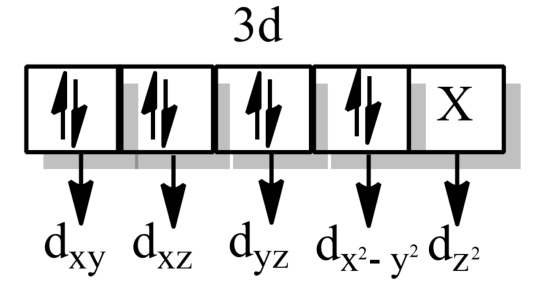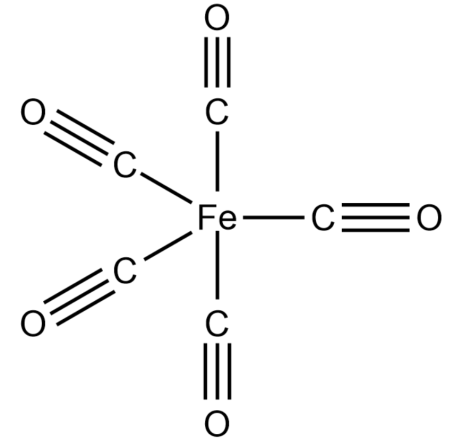Answer
64.8k+ views
Hint: Finding the hybridization of the central metal atom will tell the structure of the complex. Hybridization is the process of combining and mixing of atomic orbitals from the same atom to form an entirely new hybrid orbital having the same energy.
Complete step by step solution:
-In simple words, the concept of intermixing of two atomic orbitals with the same energy levels giving rise to the degenerate type of orbitals.
-In hybridization, the atomic orbitals of only similar energy can take parts such as the mixing of two ‘s’ orbitals or two ‘p’ orbitals or an ‘s’ orbital with a ‘p’ orbital or ‘s’ orbital with a ‘d’ orbital.
-The atomic orbitals taking part in hybridization can be both, full-filled or half-filled orbitals provided they must have similar energy.
-Finding the hybridization of $Fe{{(CO)}_{5}}$complex,
Electronic configuration of Fe in the ground state- $[Ar]3{{d}^{6}}4{{s}^{2}}$
Electronic configuration of Fe in an excited state- $[Ar]3{{d}^{6}}4{{s}^{2}}$, as the iron in the complex, is in zero oxidation state.
According to Valence Bond theory,

From spectrochemical series, CO being a strong field ligand thus will cause the pairing of electrons.

where X is the orbitals occupied by the ligand CO.
Therefore, hybridization will be $ds{{p}^{3}}$.
-According to Crystal field theory,

-When the hybridization is $ds{{p}^{3}}$, the shape will be trigonal bipyramidal and the d-orbital involved in hybridization will be $d{{z}^{2}}$.

So, the correct option is (C).
Note: When the coordination number is 2, the geometry of the complex is linear. When the coordination number is 3, the geometries can be trigonal planar geometry, trigonal pyramid geometry, or T-shaped. When the coordination number is 4, the geometries can be tetrahedral or square planar. When the coordination number is 5, the geometries can be square pyramidal or trigonal bipyramidal. When the coordination number is 6, the geometries can be a hexagonal planar, trigonal prism, or octahedral.
Complete step by step solution:
-In simple words, the concept of intermixing of two atomic orbitals with the same energy levels giving rise to the degenerate type of orbitals.
-In hybridization, the atomic orbitals of only similar energy can take parts such as the mixing of two ‘s’ orbitals or two ‘p’ orbitals or an ‘s’ orbital with a ‘p’ orbital or ‘s’ orbital with a ‘d’ orbital.
-The atomic orbitals taking part in hybridization can be both, full-filled or half-filled orbitals provided they must have similar energy.
-Finding the hybridization of $Fe{{(CO)}_{5}}$complex,
Electronic configuration of Fe in the ground state- $[Ar]3{{d}^{6}}4{{s}^{2}}$
Electronic configuration of Fe in an excited state- $[Ar]3{{d}^{6}}4{{s}^{2}}$, as the iron in the complex, is in zero oxidation state.
According to Valence Bond theory,

From spectrochemical series, CO being a strong field ligand thus will cause the pairing of electrons.

where X is the orbitals occupied by the ligand CO.
Therefore, hybridization will be $ds{{p}^{3}}$.
-According to Crystal field theory,

-When the hybridization is $ds{{p}^{3}}$, the shape will be trigonal bipyramidal and the d-orbital involved in hybridization will be $d{{z}^{2}}$.

So, the correct option is (C).
Note: When the coordination number is 2, the geometry of the complex is linear. When the coordination number is 3, the geometries can be trigonal planar geometry, trigonal pyramid geometry, or T-shaped. When the coordination number is 4, the geometries can be tetrahedral or square planar. When the coordination number is 5, the geometries can be square pyramidal or trigonal bipyramidal. When the coordination number is 6, the geometries can be a hexagonal planar, trigonal prism, or octahedral.
Recently Updated Pages
Write a composition in approximately 450 500 words class 10 english JEE_Main

Arrange the sentences P Q R between S1 and S5 such class 10 english JEE_Main

What is the common property of the oxides CONO and class 10 chemistry JEE_Main

What happens when dilute hydrochloric acid is added class 10 chemistry JEE_Main

If four points A63B 35C4 2 and Dx3x are given in such class 10 maths JEE_Main

The area of square inscribed in a circle of diameter class 10 maths JEE_Main



